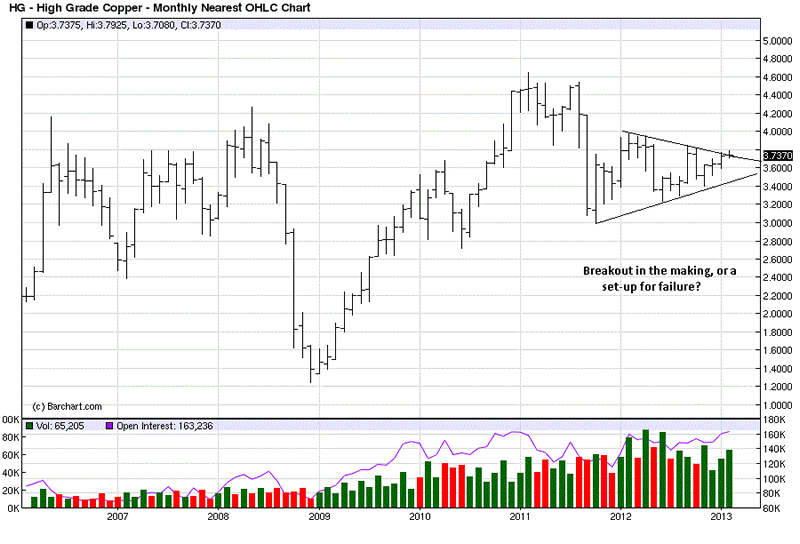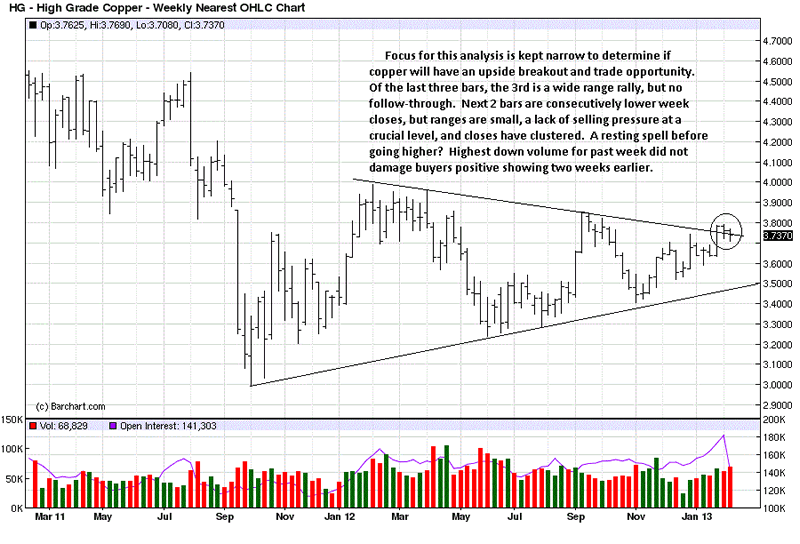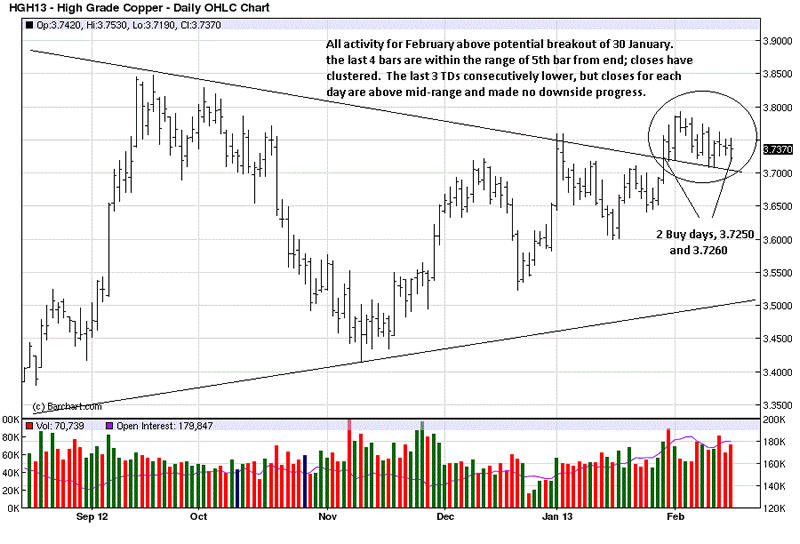Copper Poised For Breakout While Gold And Silver Falter
Commodities / Copper Feb 17, 2013 - 11:06 AM GMTBy: Michael_Noonan
 One concept to keep in mind when making a trade selection is that of relative
One concept to keep in mind when making a trade selection is that of relative
strength. Given the choice of two or more trade candidates to buy, always go
with the strongest performer. When selling, always sell the weakest one. This
is a simple factor that often gets overlooked. Go with proven strength. Go with
anything that is proven or confirmed. The odds are then in your favor.
Given a choice of potential candidates, in this case metals, many will stick with
sentimental favorites, or choose a weaker of the two or three possibilities on the
basis that the weaker one will “catch up.” Wrong, wrong, wrong. There may be
times when that can and will happen, but on balance, relative strength will keep
its edge, and anytime you can gain an edge in trading, take it.
Copper is on the verge of an upside breakout, which we think started at the end
of January, the 30th to be exact, or it can be setting up for a massive failure.
Anything can happen in the markets, but you base your decisions on what is known
and not on what may or may not happen. Could the potential breakout fail? Yes.
Based on what is known, as of Friday, the odds say No.
To the charts.
Trend and market harmony are the most important considerations. We can all see from
the monthly a series of higher highs and higher lows up until September 2011 when price
entered into a triangle or wedge formation. We pose the question, is this a breakout in
the making, or is it a set-up for failure?
The reason is because we see the last three months are smaller in range to the upside,
relative to the larger downside bar, 5th from the end. It is always important to view as
many sides as possible so as not to get lulled into missing subtle clues. In the end, you go
with the stronger points that make the case.
The current monthly bar is just barely above the supply line, like a rising sunset or a
periscope about to go back down. Monthly charts are not used for timing, and what we
take away from the monthly is the trend: Up.

We admit to a myopic look at copper because it is at a specific juncture that must prove
itself as a breakout in the making. There are other considerations, to be sure, but if the
potential move fails at the starting line, other factors become non-issues in the analysis.
You can read the comments on the chart instead of repeating them here. What we see as
key are the last three weeks, and last week in particular as the possible tipping point for
higher prices to come.
Last week was the highest volume since the end of November, and the week closed lower
than the previous two, but not very convincingly. In fact, we take the counter-argument
that the volume was net buying. Why? On increased effort, [volume], sellers were unable
to extend the range lower. Why? Because buyers were taking everything being offered,
thus preventing price from moving lower. At least, that is our common sense POV. [Point of view].
Markets are consistently full of logic.

We spoke of trend and harmony, at the outset of this analysis on the monthly. There is
consistency in all three time frames supportive of how we read developing market activity
in the present tense. All of the trading days in February are above the supply line because
of the current Mar contract, v expiring front-month contracts on the monthly and weekly.
Again, we narrow the focus, this time to the last five TDs on the chart. 5th bar from the
end was a sell-off with no downside follow-through. What happened to the sellers? The
next 4 TDs are within that Monday range. All four closes form a cluster with each one barely lower than the other.
Despite the increase in volume for the last 3 TDs, [Trading Days], closes are above mid-
range each bar, and the lows stayed above a 50% retracement area for the week. There
are two Buys marked on the chart. One was on the breakout day of 30 January, [See
Copper - Upside Breakout, http://bit.ly/XPGW2u, last chart], and based upon Friday’s
sell-off, while gold and silver were getting hit hard, copper held well, so a second position
was added, with notice given during the day in the Trade Recommendation section. Here
is where the relative strength factor comes in.
We also did an analysis of 60 and 20 minute charts to see the character of each day’s bar
composition. Volume for each day was highest at the low, [smart money buying from
weak hands exiting/selling], and the closes were above mid-range-to-higher on each day.
If copper were to fail and not rally, volume would have been at the highs of each day’s
intra day activity, which was not the case.
It was a “no-brainer” to add another position on a sell-off that demonstrated it was not
really selling off very much, and we read developing market activity as buying, anticipating
a rally soon to follow. We see copper as a “Go With” trade until proven otherwise.

By Michael Noonan
Michael Noonan, mn@edgetraderplus.com, is a Chicago-based trader with over 30 years in the business. His sole approach to analysis is derived from developing market pattern behavior, found in the form of Price, Volume, and Time, and it is generated from the best source possible, the market itself.
© 2013 Copyright Michael Noonan - All Rights Reserved Disclaimer: The above is a matter of opinion provided for general information purposes only and is not intended as investment advice. Information and analysis above are derived from sources and utilising methods believed to be reliable, but we cannot accept responsibility for any losses you may incur as a result of this analysis. Individuals should consult with their personal financial advisors.
Michael Noonan Archive |
© 2005-2022 http://www.MarketOracle.co.uk - The Market Oracle is a FREE Daily Financial Markets Analysis & Forecasting online publication.



